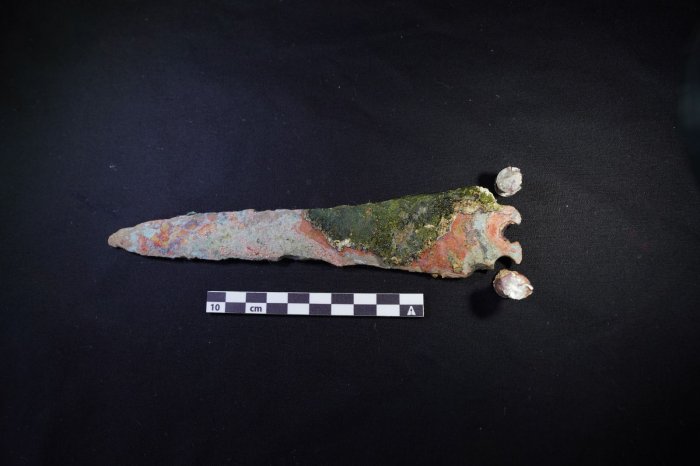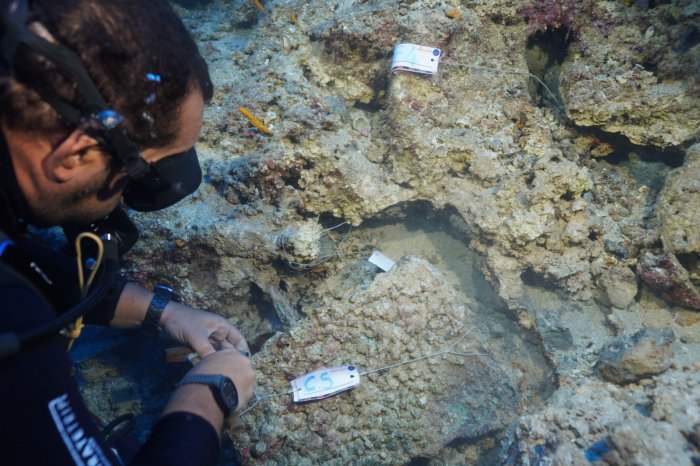3,600-Year-Old Bronze Dagger Made By The Minoan Civilization Found On Ancient Shipwreck

Jan Bartek – AncientPages.com – In a significant discovery near Kumluca, Antalya, in the depths of the Mediterranean Sea off the coast of Turkey, underwater archaeologists have retrieved a remarkable 3,600-year-old bronze dagger linked to the Minoan civilization. This dagger, adorned with silver rivets, was uncovered during excavations conducted by a team from Akdeniz University.
Credit: Türkiye Ministry of Culture
The Minoans were an advanced Bronze Age civilization in Europe. Their society emerged at the end of the third millennium B.C. on Crete—the largest island in the Aegean Sea—under the rule of King Minos, who was said to be a son of Zeus and Europa. The Minoans also inhabited many smaller islands within the Aegean Sea. Their flourishing period spanned from around 3000 B.C. to approximately 1000 B.C. (from about the 27th century B.C. to the 15th century). They are recognized as one of the earliest cultures of the Bronze Age in this region. They were comparable in their achievements to older civilizations such as Egypt, Mesopotamia, and Anatolia.
The term ‘Minoan’ was coined by British archaeologist Sir Arthur Evans (1851-1941), who unearthed this previously unknown civilization and confirmed ancient accounts of Cretan society.
The recently discovered Minoan dagger was found aboard a ship that met a tragic end. The shipwreck, located 50 meters (164 feet) below the surface, once carried valuable cargo from the Troodos Mountains in Cyprus. Reports indicate that the vessel was en route to Crete when it sank. Believed to be one of the oldest shipwrecks globally, this Bronze Age wreck off Kumluca, Antalya dates back to the 16th century B.C. Researchers under Türkiye’s Ministry of Culture have focused on documenting the site in situ with limited sample extractions to enhance understanding.
Credit: Türkiye Ministry of Culture
The discovery of the Minoan dagger has significantly increased interest in this shipwreck. Described as one of the most important finds in underwater archaeology in Türkiye and worldwide, this artifact provides an unprecedented glimpse into the complex network of cultural and commercial exchanges that characterized the Mediterranean over three millennia ago.
For specialists, determining the dagger’s origin is crucial, as it suggests the vessel was heading to Crete when it sank. This hypothesis paves the way for new research into ancient maritime routes linking Aegean islands with Anatolia and other regions of the eastern Mediterranean. Moreover, this discovery prompts inquiries regarding the nature of transported goods and provides valuable insights into the historical context surrounding this shipwreck.
Credit: Türkiye Ministry of Culture
The bronze dagger adorned with silver rivets transcends its status as a mere ancient artifact, a silent testament to a bygone era. Through meticulous study, archaeologists endeavor to uncover further details about trade practices, military strategies, and diplomatic relations during the Bronze Age. Additionally, examining this object illuminates Minoan metallurgy and craftsmanship—underscoring their advancements in navigation and shipbuilding techniques.
See also: More Archaeology News
“This discovery is not only significant for Türkiye but also for world underwater archaeology. I thank the teams who, with meticulous work, have brought to light the traces of civilizations hidden in the depths of the Mediterranean,” Türkiye’s Minister of Culture and Tourism, Mehmet Nuri Ersoy, wrote on social media.
Written by Jan Bartek – AncientPages.com Staff Writer
Expand for references
Mehmet Nuri Ersoy (Türkiye’s Minister of Culture)







